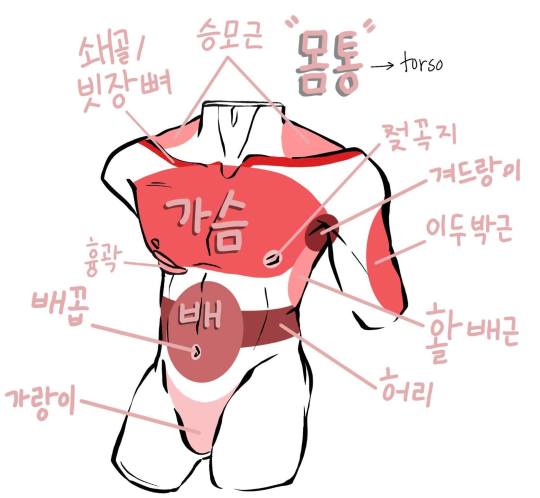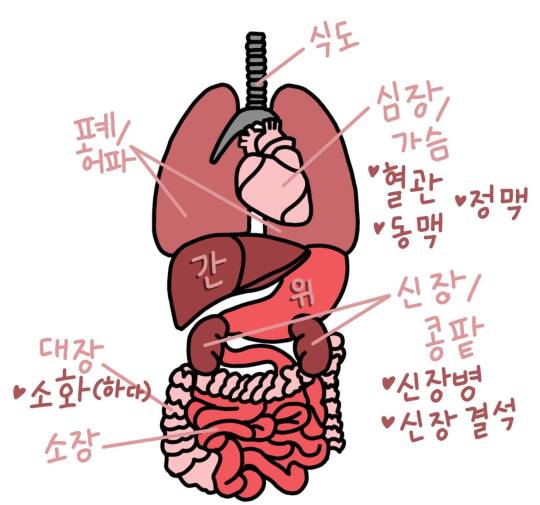#studykorean101
anon asked: what’s the difference between 부터&까지 and 에서&까지? Please let me know
안녕하세요! Hello! The difference is quite simple :)
부터 ~ 까지: (시간)
- specific to time in general
♡ Example Sentences:
- 1시부터 2시까지 친구를 만났어요
I met my friend from 1:00 to 2:00 - 월요일부터 금요일까지 일해요
I work from Monday to Friday
에서 ~ 까지: (장소)
- specific to distance, destination, and place
♡ Example Sentences:
- 캐나다에서 한국까지 어떻게 가요?
How do I get from Canada to Korea? - 학교에서 대학로까지 버스로 갔어요
I went from school to Daehangno by bus
Hope this helped! If you need any more examples, let me know! These are pretty good grammatical points to know.
Happy Learning :)
~ SK101
A lot of people liked PART TWO a lot! Thank you for all your kind comments and praise! PART THREE will cover the skin and necessary vocabulary underneath. Enjoy <3

*picture is of a chest (half skeleton, half muscle) and a skull (necessary vocabulary is highlighted)
- 뼈대 - skeleton
- skeleton can also be translated as: 해골 and 골격
- major differences between 뼈대, 해골, and 골격: 뼈대 and 해골 are the most similar. Sometimes 해골 can refer to only the skull (see skull for a better understanding) - both of these refer to dead skeletons. However, 해골 comes from 한자 ‘骸骨’. The word 골격 also comes from 한자 meaning 骨格 (frame, figure) or 骨骼 (skeleton).
- 근육 - muscle
- 뼈 - bone
- 인대 - ligament
- 살 - flesh (not skin, but the ‘meaty-like’ part; almost like fat)
- 관절 - joint
- 두개골 / 해골 - skull
- major difference between 두개골 and 해골: both come from 한자 ( 두개골 = 頭蓋骨 // 해골 = 骸骨), however, 해골 (according to a Korean native speaker), refers to the picture of a skull. Whereas 두개골 refers to the actual, physical skull.
- 광대뼈 - cheekbone
- 아래턱뼈 - mandible (jaw)
- 코뼈 - nasal bone
Example Sentences:
- 다행히뼈에는 이상이 없나요 - Fortunately, there is nothing wrong with the bone(theboneis alright/not broken).
- 우리 오빠는 축구를 하다 인대가 늘어났어요 - My brother pulled a ligamentwhile playing soccer.

*picture is of an eye and a pair of lips with blemishes (necessary vocabulary is highlighted)
- 피부 - skin
- 여드름 - pimple / zit
- 기미 / 주근깨 - freckles
- major difference between 기미 and 주근깨: 기미 refers to spots you get from the sun (not usually pleasant) while 주근깨 translated to actual freckles
- 다래끼 - sty
- 수염 - facial hair (this can be a mustache or beard)
- 애교 살 - the fatty pocket under the eyes
- 다크서클 - dark circles
- 점 - mole, spot
- 흉터 / 흠 - a scar, blemish
- major difference between 흉터 and 흠: 흉터 refers to an actual scar made a long time ago whereas 흠 considers all types of blemishes or flaws on the skin
- not to be confused with 상처 (injury/wound that JUST happened) and 멍자국 (bruise)
- 입슬허피스 / 입슬의 발진 - cold-sore
- difference: 입슬허피스 = lip herpes VS 입슬의 발진 = lip rash
Example Sentences:
- 여드름을 짜다가 세균에 감염될 수도 있어요 - If you pop your pimples, you might spread germs.
- 저는 작녀에 얼굴에 있는 점들을 뺐어요 - I had a few molesremoved.
Extra Vocab to Know:
- 주름(살) - wrinkles / crease
- 혹 - bump / lump
- 땀 - sweat
- 눈곱 - sleep (the goop in your eye when you wake up; eye boogies)
- 하품(하다) - sigh (to sigh)
- 방귀 - fart
- 트림(하다) - burp (to burp)
- 소름 - goosebumps / goose pimples
- 딸꾹질(하다) - hiccup (to hiccup)
I received an ask last night asking about the word for ‘throat’. You could use 목 to describe your throat but a more technical term would be 목구멍. However, this isn’t used as often. For example:
목이 아프다 - a sore throat
희주는 눈물에 목이 메였다 - tears clogged Hee-Ju’s throat
Hope that clears up some confusion!
Happy Learning :)
~ SK101
As promised, here’s PART TWO of the in depth body vocab!PART ONEcovered the face / head. Today we will look at the back, torso, and most internal organs. Enjoy <3

*picture is of a male presenting torso (necessary vocabulary is highlighted)
- 몸통 - torso
- 승모근 - traps
- 쇄골 / 빗장뼈 - collar bone
- major difference between 쇄골 and 빗장뼈: Both can translate to the scientific name ‘clavicle’. However, 쇄골 comes from 한자: ‘鎖骨’.
- 흉곽 - ribcage
- 가슴 - chest / breast
- 젖꼭지 - nipple
- 겨드랑이 - armpit
- 겨드랑이 털 - armpit hair
- 이드박근 - bicep
- 배 - belly, stomach (exterior)
- 배꼽 - bellybutton
- 활배근 - lats
- 허리 - waist
- 가랑이 - crotch
Example Sentences:
- 저는겨드랑이에서 땀이 괴도하게 났었어요 - I used to sweat a lot in my armpits
- 밥을 많이 먹어서 배가 너무 불러요 - My stomachis full because I ate too much

*blank back cut off at the legs and neck (necessary vocabulary is highlighted)
- 등 - back
- 목 - neck
- 어깨 - shoulder
- 팔 - arm
- 왼팔 - left arm
- 오른팔 - right arm
- 양팔 - both arms
- 삼두근 - triceps
- 팔꿈치 - elbow
- 척추 - spine
- not to be confused with 척수 which refers to the spinal cord
- 허리 - waist
- 옆구리 - side
- 허리께 - hip
- 엉덩이 - butt / buttocks
Example Sentences:
- 양팔을 위로 줄 뻗어 보세요 - Please stretch your armsout
- 하루 종일 앉아 있었더니엉덩이가 아파요 - My butthurts from sitting on it all day

*picture of internal organs including the lungs, heart, liver, stomach, kidneys, and intestines (necessary vocabulary is highlighted)
- 장기 - organ
- 식도 - esophagus (’gullet’ in reference to animals)
- 폐 / 허파 - lung
- major difference between 폐 and 허파: 폐 is used in more medical contexts over 허파
- 심장 / 가슴 - heart
- major difference between 심장 and 가슴: 심장 refers to the literal pumping organ whereas 가슴 is the general area of the chest but can be used as an emotional heart (as opposed to 마음, which is the feeling in your heart)
- 혈관 - blood vessel
- 정맥 - vein
- 동맥 - artery
- 간 - liver
- 위 - stomach (internal)
- 신장 / 콩팥 - kidney
- major difference between 신장 and 콩팥: 신장 comes from 한자: ‘腎臟’, where 콩팥 is the native Korean version.
- 신장병 - kidney disease
- 신장 결석 - kidney stone
- 장 - intestine
- 대장 - large intestine
- 소장 - small intestine
- 소화 (하다) - digestion (to digest)
- 혈액 / 피 - blood
- major difference between 혈액 and 피: 혈액 is the medical form!
Example Sentences:
- 저는 수년간 위에 문제가 있어 왔어요 - I’ve had issues with my stomach for years
- 어젯밤 먹은 게 고화가 잘 안 돼요 - I’m having trouble digesting what I ate last night
Extra Vocab to Know:
- 배설(하다) - excretion (to excrete)
- 대변 / 똥 - stool or poop
- major difference between 대변 and 똥: 대변 is more like feces whereas 똥 is much more casual in speech
- 소변 / 오줌 - urine or pee
- major difference between 소변 / 오줌: same as above, 소변 is more like urine where 오줌 is more casual
- both 소변 and 대변 come from 한자: 大便 (대변) and 小便 (소변)
- 싸다 - to poop/pee
- 누다 - to poop
- 음경 - penis
- 자궁 - womb
This is obviously for educational purposes, so I hope tumblr lets it stay up. But here’s PART TWO of the in depth body vocab!
Happy Learning :)
~ SK101
anon asked: 안녕하습니다 for the request thing can you do a more indepth blog on the body? 고맙습니다
Yes! I very much can! To piggyback off this ask, I’m going to include certain systems of the body as well. This will be PART ONE of the in depth body posts! Please refer to my first body post to get the basics!

*pictured above is a plain face with closed eyes, highlighting the ears (vocabulary pointing to the necessary region)
- 머리 / 고개 - head
- major difference between 머리 and 고개: 머리 is used for the general region of the head (plus the brain and everything inside) whereas 고개 is used primarily for any movement of the head.
- 머리카락 / 머리칼 - hair
- 얼굴 / 낯 - face
- major difference between 얼굴 and 낯: 얼굴 refers to a physical face whereas 낯 refers to a mental/abstract face (see examples below).
- 이마 - forehead
- 눈 - eye
- 코 - nose
- 입 - mouth
- 턱 - chin
- 볼 / 빰 - cheek
- major difference between 볼 and 빰: 볼 refers to the centre of the cheek whereas 빰 refers to the general area. For example, you would pinch 볼 but slap 빰.
- 귀 - ear
- 귓속 - inner ear
- 코클레어 / 달팽어관 - cochlea
- 청각 신경 - auditory nerve
- 안면 신경 - facial nerve
- 중이 - middle ear
- 고막 - eardrum
- 외이 - outer ear
- 연골 - cartilage
Example Sentences:
- 태호는 낙담해서 고개를 저었어요 - Tae-Ho shook his headin despair.
- 음식에머리칼이 있습니다! - There’s a hairin my food!
- 낯/얼굴이 뜨거워요:
낯 = I’m embarrassed > the faceis hot (more abstract)
얼굴 = the faceis hot > I’m embarrassed (more concrete) - 괜찮아요? 네 이마에 열이 있잖아요.. - Are you ok? Your foreheadfeels hot.
- 눈을 감고 소원을 빌어 봐요! - Close your eyesand make a wish!

*picture is of a plain face with open eyes; to the top right, the left eye is opened (vocabulary pointing to the necessary region), to the bottom right, an open mouth with a tongue sticking out (vocabulary pointing to the necessary region).
- 눈썹 - eyebrow
- 속눈썹 - eyelash
- 눈가 - eye rim (general eye area)
- 눈꺼풀 - eyelid
- 눈동자 - pupil
- 홍채 - iris
- 콧구멍 - nostril
- 코털 - nose hair
- 입술 - lips
- 혀 - tongue
- 잇몸 - gums
- 이 / 치아 - tooth
- major difference between 이 and 치아: 이 is a more casual, newer version of “tooth”, whereas 치아 is more formal and comes from 齒牙 in 한자 (sometimes, reference is related to ‘dental/dentistry’)
- not to be confused with 이빨 - tooth (usually for non-human animals)
- 어금니 - molar
- 사랑니 - wisdom tooth
Not Mentioned:
- 뇌 - brain
- 두개골 - skull
Example Sentences:
- 입술이 계속 트고 갈라져요 - My lipsare still cracked and chapped
- 혀를 내밀어 보세요 - Please stick out your tongue.
- 식사 후에 이를 꼭 닦으세요 - Make sure you brush your teethafter eating.
- 입을 크게 벌리세요 - Open your mouthwide!
Verbs to Remember:
듣다 - to listen
들리다- to hear
귀기울이다- to listen carefully
엿듣다- to eavesdrop
먹다- to eat
깜박거리다- to blink
Reminder: this is PART ONE of the in depth body posts! I got a fair amount of requests but my inbox is still open! I look forward to everyone’s ideas!
If there’s anything you’d like to add, feel free! Pictures drawn by me as all things are on this blog; please do not repost without my permission.
Happy Learning :)
~ SK101
